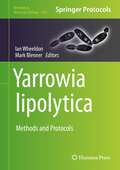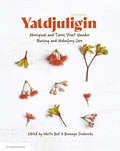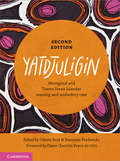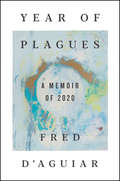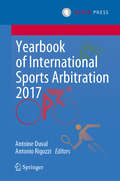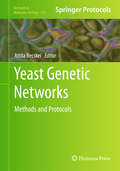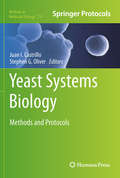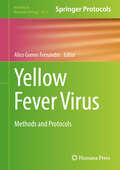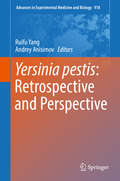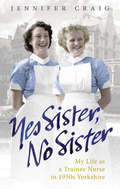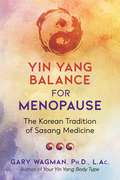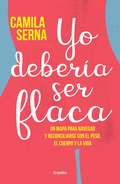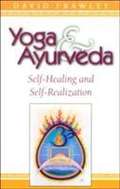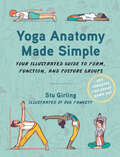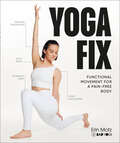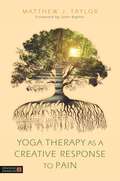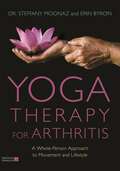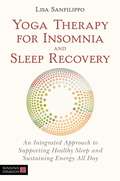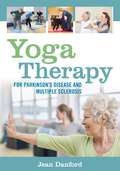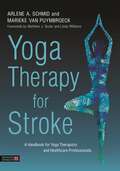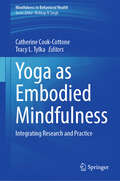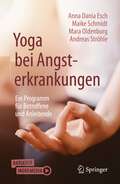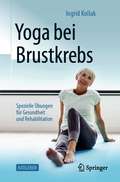- Table View
- List View
Yarrowia lipolytica: Methods and Protocols (Methods in Molecular Biology #2307)
by Ian Wheeldon Mark BlennerThis volume provides a collection of protocols for the most common experimental methods used for engineering Yarrowia lipolytica. Chapters detail the basic theories underlying the methods described in each chapter. Written in the highly successful Methods in Molecular Biology series format, chapters include introductions to their respective topics, lists of the necessary materials and reagents, step-by-step, readily reproducible laboratory protocols, and tips on troubleshooting and avoiding known pitfalls. Authoritative and cutting-edge, Yarrowia lipolytica: Methods and Protocols aims to provide experimentalists with a full account of the practical steps necessary for carrying out each protocol successfully.
Yatdjuligin
by Odette Best Bronwyn FredericksYatdjuligin: Aboriginal and Torres Strait Islander Nursing and Midwifery Care introduces students to the fundamentals of the healthcare of Indigenous Australians, from the perspective of both the patient and the professional. Aboriginal Elder Ivy Molly Booth gifted the word Yatdjuligin to the authors to use as the title of this textbook. The word Yatdjuligin literally translates to 'talking in a good way'. For Wakgun people the process of Yatdjuligin is deeply embedded in learning. Written by a team of Aboriginal and Torres Strait Islander nursing and midwifery academics, and practising nurses, this book is designed for both non-Indigenous and Indigenous nurses, who will work with Aboriginal and Torres Strait Islander patients. The book includes chapters on the history of health service provision for Australian Indigenous people, gender, midwifery, community-controlled health services, remote area nursing, mental health and caring for Indigenous Elders, and features case studies and critical thinking questions.
Yatdjuligin: Aboriginal and Torres Strait Islander Nursing and Midwifery Care
by Odette Best Bronwyn FredericksYatdjuligin: Aboriginal and Torres Strait Islander Nursing and Midwifery Care introduces students to the fundamentals of health care of Indigenous Australians, encompassing the perspectives of both the client and the health practitioner. Written for all nurses and midwives, this book addresses the relationship between Aboriginal and Torres Strait Islander cultures and mainstream health services and introduces readers to practice and research in a variety of healthcare contexts. This new edition has been fully updated to reflect current research and documentation, with an emphasis on cultural safety. Three new chapters cover Torres Strait Islander health and wellbeing, social and emotional wellbeing in mainstream mental health services and quantitative research. Chapter content is complemented by case study scenarios, author reflections and reflection questions. These features illustrate historical and contemporary challenges, encourage students to reflect on their own attitudes and values, and provide strategies to deliver quality, person-centred health care.
Yatdjuligin: Aboriginal and Torres Strait Islander Nursing and Midwifery Care (2nd Edition)
by Odette Best Bronwyn FredericksYatdjuligin: Aboriginal and Torres Strait Islander Nursing and Midwifery Care introduces students to the fundamentals of the health care of Indigenous Australians from the perspectives of both the patient and the professional. Designed for both non-Indigenous and Indigenous nurses and midwives who will work with Aboriginal and Torres Strait Islander patients, this book addresses the relationship between Aboriginal and Torres Strait Islander cultures and mainstream health services, and prepares students for practice in a variety of contexts. Fully updated to reflect the latest research, this new edition includes new chapters on child health and mental health. Updated online resources provide lecturers with resources to support student learning. Written by leading Aboriginal and Torres Strait Islander nursing and midwifery academics and practising nurses, Yatdjuligin is an indispensable resource that encourages students to reflect on their values and attitudes towards Indigenous people and health.
Year of Plagues: A Memoir of 2020
by Fred D'AguiarIn this piercing and unforgettable memoir, the award-winning poet reflects on a year of turbulence, fear, and hope.For acclaimed British-Guyanese writer Fred D’Aguiar, 2020 was a year of personal and global crisis. The world around him was shattered by the impact of the Covid-19 pandemic, Black Lives Matter protests erupted across the United States, California burned, and D’Aguiar was diagnosed with stage 4 cancer.Year of Plagues is an intimate, multifaceted exploration of these seismic events. Combining personal reminiscence and philosophy, D’Aguiar confronts profound questions about the purpose of pursuing a life of writing and teaching in the face of overwhelming upheavals; the imaginative and artistic strategies a writer can bring to bear as his sense of self and community are severely tested; and the quest for strength and solace necessary to help forge a better future. Drawn from two cultural perspectives—his Caribbean upbringing and his American lifestyle—D’Aguiar’s beautiful and challenging memoir is a paean of resistance to despotic authority and life-threatening disease.In his first work of nonfiction, D’Aguiar subverts the traditional memoir with highly charged language that shifts from the lyrical to the quotidian, from the metaphysical to the personal. While his experience could not be darker, its rendering is tinged with light and joy, captured in prose that unfolds in wonderful, unexpected ways. Both tender and ferocious, Year of Plagues is a harrowing yet uplifting genre-bending memoir of existence, protest, and survival.
Yearbook of International Sports Arbitration 2017 (Yearbook of International Sports Arbitration)
by Antoine Duval Antonio RigozziThe Yearbook of International Sports Arbitration is the first academic publication aiming to offer comprehensive coverage, on a yearly basis, of the most recent and salient developments regarding international sports arbitration, through a combination of general articles and case notes. The present volume covers decisions rendered by the Court of Arbitration for Sport (CAS) and national courts in 2017. It is a must have for sports lawyers and arbitrators, as well as researchers engaged in this field. It provides in-depth articles on current issues raised by international sports arbitration, and commentaries by esteemed academics and experienced practitioners on the most important decisions of the year by the CAS and national courts.Dr. Antoine Duval is Senior Researcher at the T.M.C. Asser Instituut in The Hague and heads the Asser International Sports Law Centre. Prof. Antonio Rigozzi teaches international arbitration and sports law at the University of Neuchâtel, Switzerland, and is the partner in charge of the sports arbitration practice at Lévy Kaufmann-Kohler, a Geneva-based law firm specializing in international arbitration.
Yeast Genetic Networks
by Attila BecskeiRegulation of gene expression, a major determinant of gene activity, occupies a central place in molecular biology. Yeast Genetic Networks: Methods and Protocols covers approaches to the systems biological analysis of small-scale gene networks in yeast. Divided into four convenient sections, this detailed volume discusses the methods used to analyze gene expression quantitatively, presents a collection of mathematical and computational tools to analyze stochasticity, adaptation, sensitivity in signal transmission, and oscillations in gene expression, provides instructional methods on how to utilize the tools of quantitative genetics to identify genes that regulate stochasticity and oscillations in gene expression, and concludes with a section devoted to the analysis of conserved gene expression systems and networks in different fungal species. Written in the highly successful Methods in Molecular BiologyTM series format, chapters contain introductions to their respective topics, lists of the necessary materials and reagents, step-by-step, readily reproducible laboratory protocols, and notes on troubleshooting and avoiding known pitfalls. Authoritative and accessible, Yeast Genetic Networks: Methods and Protocols serves as an ideal and valuable resource for both novices and experienced researchers.
Yeast Systems Biology
by Juan I. Castrillo Stephen G. OliverSystems Biology aims at deciphering the genotype-phenotype relationships at the levels of genes, transcripts (RNAs), peptides, proteins, metabolites, and environmental factors participating in complex cellular networks in order to reveal the mechanisms and principles governing the behavior of complex biological systems. Yeast Systems Biology: Methods and Protocols presents an up-to-date view of the optimal characteristics of the yeast Saccharomyces cerevisiae as a model eukaryote, perspective on the latest experimental and computational techniques for systems biology studies, most of which were first designed for and validated in yeast, and selected examples of yeast systems biology studies and their applications in biotechnology and medicine. These experiments under controlled conditions can uncover the complexity and interplay of biological networks with their dynamics, basic principles of internal organization, and balanced orchestrated functions between organelles in direct interaction with the environment as well as the characterization of short and long-term effects of perturbations and dysregulation of networks that may illuminate the origin of complex human diseases. Written for the highly successful Methods in Molecular BiologyTM series, this volume contains the kind of detailed description and implementation advice that is crucial for getting optimal results. Practical and cutting-edge, Yeast Systems Biology: Methods and Protocols serves researchers interested in comprehensive systems biology strategies in well-defined model systems with specific objectives as well as a better knowledge of the latest post-genomic strategies at all 'omic levels and computational approaches towards analysis, integration, and modeling of biological systems, from single-celled organisms to higher eukaryotes.
Yellow Fever Virus: Methods and Protocols (Methods in Molecular Biology #2913)
by Alice Gomes FernandesThis volume covers a range of fundamental and advanced techniques and methods used by researchers to study the control of yellow fever. The chapters in this book cover a broad range of topics including epidemiological studies that track the spread of disease and sophisticated laboratory techniques that investigate the disease’s pathogenesis. Written in the highly successful Methods in Molecular Biology series format, chapters include introductions to their respective topics, lists of the necessary materials and reagents, step-by-step, readily reproducible laboratory protocols, and tips on trouble shooting and avoiding known pitfalls. Cutting-edge and comprehensive, Yellow Fever Virus: Methods and Protocols is a valuable guide for students, researchers, and health professionals who are looking to understand and combat yellow fever. This book will inspire new discoveries, collaborations, and initiatives that will bring humanity closer to eradicating this disease.
Yersinia pestis: Retrospective and Perspective
by Ruifu Yang Andrey AnisimovThis book addresses nearly every aspect of Y. pestis, approaching it from a new perspective. Topics covered include the history, epidemiology, physiology, ecology, genome, evolution, pathogenesis, host-pathogen interaction, big-data-driven research, vaccines, clinical aspects and future research trends. For centuries, scientists have sought to determine where Y. pestis, the most well-known bacterium and one that has caused a number of high-mortality epidemics throughout human history, comes from, what it is and how it causes the disease. This book works to answer these questions with the help of cutting-edge research results. It not only describes the history of plagues, but also stresses plagues' effects on human civilization and explores the interaction of Y. pestis with hosts, vectors and the environment to reveal the evolution and pathogenesis. The book offers a valuable guide for researchers and graduate students studying Y. pestis, and will also benefit researchers from other fields, such as infectious diseases, other pathogens and system biology, sharing key insights into bacterial pathogen studies.
Yes Sister, No Sister: My Life as a Trainee Nurse in 1950s Yorkshire
by Jennifer Craig'What is your name?' she asks, staring at me.'Jennifer Ross.''Jennifer Ross, Sister. Well, Nurse Ross, you are dressed in the uniform of a nurse from the Leeds General Infirmary. Such a uniform is not worn with a cardigan. Take it off at once.''Yes Sister.' I can feel my face turn red.A trainee nurse in the 1950s had a lot to bear. In Jennifer Craig's enchanting memoir, we meet these warm-hearted yet naïve young girls as they get to grips with strict discipline, long hours and bodily fluids. But we also see the camaraderie that develops in evening study sessions, sneaked trips to the cinema and mischievous escapades with the young trainee doctors. The harsh conditions prove too much for some girls, but the opportunity to help her patients in their time of need is too much of a pull for Jenny. As she commits to her vocation and knuckles down to her exams, she is determined that when she reaches the heights of Ward Sister herself she will not become the frightening matron that struck fear into her student heart ...Rich in period detail, and told with a good dose of Yorkshire humour, Yes Sister, No Sister is a life-affirming true story of a life long past.
Yin Yang Balance for Menopause: The Korean Tradition of Sasang Medicine
by Gary WagmanA practical guide to using your Korean Sasang body type to optimize your health during menopause • Explores how each of the four Sasang body types has its own unique menopausal symptoms and Yin-Yang energy balance, explaining why hot flashes occur when they do, why insomnia is suddenly an issue, or why you feel depressed • Provides self-tests to determine your Sasang body type and explains how the natural remedies and diets that work for one type might not work for another • Includes Sasang herbal remedies for common challenges related to menopause, including hot flashes, depression, mood swings, brain fog, and loss of libido The ancient Korean art of Sasang medicine explains how each of us is born with a specific body type that establishes our physical and emotional strengths and weaknesses. These traits have a direct influence on how we interact with others and react to stress and life’s transitions. Discovering your type will enable you to understand why you are prone to certain symptoms and not others, choose the most compatible remedies and treatments, and make the best choices regarding your health and well-being. Applying the wisdom of Sasang medicine to the major life transition of menopause, Dr. Gary Wagman explores how each of the four Sasang body types has its own unique menopausal challenges, as well as opportunities, and how the natural remedies and diets that work for one type might not work for another. Providing guidelines and tests to determine your type, he details each type’s emotional tendencies, physical strengths and weaknesses, and their balance of Yin and Yang energy within the organ systems, explaining why hot flashes occur when they do, why insomnia is suddenly an issue, or why you feel depressed. Revealing the impact our emotions have on our physiological health, he describes how different emotions, such as anger and sadness, correlate with a particular type’s inborn energetic patterns. Presenting natural remedies, exercises, supplements, and diet and food recommendations for each Yin-Yang body type, Dr. Wagman also includes body-type-specific Sasang herbal remedies for the most common challenges related to menopause, including hot flashes, osteoporosis, depression, mood swings, hormone balance, urinary health, fibroids, frozen shoulder, brain fog, and loss of libido. Offering specific ways to take charge of your own emotional, physical, and sexual health, this practical guide provides a compass to help you smoothly navigate the sometimes turbulent waters of menopause and harness the spiritual and emotional strengths of this life transition.
Yo debería ser flaca: Un mapa para navegar y sanar la lucha con el peso, el cuerpo y la vida
by Camila SernaHaz una pausa y llénate de argumentos para eliminar poco a poco las falsas creencias que han rodeado el ideal del cuerpo femenino. Esta es la oportunidad de iniciar un camino de reconciliación, aceptación y amor propio. Muchas mujeres enfrentan a diario una lucha con la comida y viven intranquilas con la relación que tienen con su cuerpo. Para ponerle fin a esta insatisfacción, y luego de librar su propia batalla, la coach de nutrición integrativa Camila Serna usa su experiencia para estimular a otras personas a tomar la decisión de aceptarse y sanar su mente. Este no es un libro de dietas ni de consejos para comer de una manera determinada. Escrito en un tono irreverente y mordaz, Yo debería ser flaca es una reflexión necesaria para aquellas que viven en un conflicto permanente con sus emociones, quieren reconciliarse con su cuerpo y volver a creer en sí mismas.
Yoga & Ayurveda: Self-Healing and Self-Realization
by David FrawleyThe book offers a most valuable overview of the connecting points between Yoga and Ayurveda and shows how both disciplines are relevant to contemporary spiritual practice.
Yoga Anatomy Made Simple: Your Illustrated Guide to Form, Function, and Posture Groups
by Stu GirlingA fun introductory guide to yoga anatomy for new and experienced yoga teachers, practitioners, and enthusiastsKnowledge of anatomy is a crucial part of every effective yoga practice, but the subject can be dry and difficult. Yoga Anatomy Made Simple provides a fun solution—it&’s a go-to guide to functional yoga anatomy, written for yoga practitioners looking to jump in and start applying key concepts to their work. Here, longtime yoga teacher Stuart Girling pairs his expertise with real-life examples and colorful, jaunty illustrations to create a book that serves as a playful introduction and refresher course for yogis, teachers, and trainers.Yoga Anatomy Made Simple provides simple explanations of key yoga-anatomy concepts, like patterns, variety, breath, and strength. The illustrations are diverse, body-inclusive, joyful, and fun—and mirror the author&’s own accessible, unpretentious approach to practical yoga anatomy. Concepts are demonstrated on different body parts, as well as the following posture groups:Forward bendsHip rotationsBackbendsTwistsPostures involving the shouldersInversionsArm balancesGirling ties everything together in a holistic framework with a playful touch on every page—one that embraces each student&’s lifestyle, environment, and life history. Yoga teachers will learn to elevate their ability to analyze yoga postures from a physical perspective, sequence more effectively, avoid unnecessary injury, and appreciate the importance of individuality within postural yoga.
Yoga Fix: Functional Movement for a Pain-Free Body
by Erin MotzThis is yoga for those who don’t know their asana from their elbow.Bad back from sitting at your desk all day? Tech neck from looking at your phone too much? Is your body feeling the strains of modern life?Introducing Yoga Fix: functional yoga for a pain-free body. Get rid of that stiff neck, achy back, and tight hamstrings with fully photographed step-by-step fixes to help you feel flexible, relaxed, and twinge-free.From tension headaches, jaw pain, and rounded shoulders to pelvic floor weakness, runner’s knee, and tight quads, this head-to-toe guide to the body will show you simple poses and quick stretches to ease your aching muscles.If traditional yoga has not worked out for you, or if you simply do not have the time or money for fancy gym memberships, this book will show you how to get a quick fix of yoga that will make a big difference in how you feel.
Yoga Therapy as a Creative Response to Pain: Yoga Therapy as a Creative Response
by Matthew J. Taylor John KepnerSupporting yoga therapists to create a programme of care for those living with chronic pain, this guide brings pain science, creativity and yoga together for the first time. It includes the emotional, cognitive, social and spiritual in its definition of pain and acknowledges there that is no simple physical 'fix'. The book offers advice on creating an environment that restores hope and meaning to clients, and on building a successful business by creating a community of support. Matt Taylor's blend of creativity and yoga came from his own chronic spine pain as a physical therapist and his discovery of yoga therapy which led to his yoga-based rehabilitation clinic.
Yoga Therapy for Arthritis: A Whole-Person Approach to Movement and Lifestyle
by Dr Steffany Moonaz Erin Byron Dr CliftonYoga therapy is commonly used for the management of arthritis, but often focusses exclusively on adaptation of the physical poses and on structural solutions. This book moves beyond the traditional routines to present yoga as a lifestyle designed to improve quality of life and overall well-being for individuals living with arthritis and rheumatic conditions. By incorporating the ancient practices of yoga as both physical and mental exercises involving a model of 5-koshas or sheaths (physical, energetic, mental/emotional, wisdom, and spiritual), the yoga therapy practice presented here will help reduce pain and shift the perspective of the individual living with arthritis. This therapy uses a whole-person approach that employs a broad range of tools to address the biopsychosocial effects of arthritis through the application of yoga practices and philosophy. Useful as a guide for people living with arthritis, this book is full of inspiration for self care along with instructions for yoga teachers and medical professionals to guide their clients using this whole-person perspective.
Yoga Therapy for Insomnia and Sleep Recovery: An Integrated Approach to Supporting Healthy Sleep and Sustaining Energy All Day
by Lisa SanfilippoYoga therapy offers a truly holistic approach to solving the growing problem of insomnia. In this book expert yoga therapist Lisa Sanfilippo explains how yoga practices can be used to target the underlying issues that inhibit good quality sleep, with immediate results that build over time.Learn how to work with clients to release tension in the body that builds up during the day making it difficult to sleep at night. Honouring a natural yogic and Ayurvedic approach, and infusing it with modern neuroscience, Lisa also addresses the deeper emotional reasons for not sleeping well and looks at how lifestyle changes can help to achieve better quality rest. With the body-mind connection at its core, this book shows how to support better health holistically to restore balance in each layer of the body.
Yoga Therapy for Parkinson's Disease and Multiple Sclerosis
by Jean DanfordYoga is an extremely beneficial therapy for ameliorating physical symptoms of both Parkinson's disease (PD) and multiple sclerosis (MS), and improving emotional wellbeing through breathing, asana, relaxation and meditation. Outlining each condition, its pathology, treatment and its impact on the lives of those affected, the book describes how yoga practice can be tailored to meet the specific needs of those with PD and MS, by improving mobility, balance, strength and wellbeing. Postures are categorised by their useful application, such as joint mobilising, balance and stability, stretching, alongside guidance on how to identify what is needed. Descriptions of yoga movements are accompanied by illustrations throughout, along with sample lesson plans and the personal testimonies of those who have experienced the benefits first hand. Ideal for yoga therapists and yoga teachers working with people with PD or MS, as well as students of the practice, it will also be of interest to practitioners working with beginner client groups and those with limited mobility.
Yoga Therapy for Parkinson's Disease and Multiple Sclerosis
by Jean DanfordYoga is an extremely beneficial therapy for ameliorating physical symptoms of both Parkinson's disease (PD) and multiple sclerosis (MS), and improving emotional wellbeing through breathing, asana, relaxation and meditation. Outlining each condition, its pathology, treatment and its impact on the lives of those affected, the book describes how yoga practice can be tailored to meet the specific needs of those with PD and MS, by improving mobility, balance, strength and wellbeing. Postures are categorised by their useful application, such as joint mobilising, balance and stability, stretching, alongside guidance on how to identify what is needed. Descriptions of yoga movements are accompanied by illustrations throughout, along with sample lesson plans and the personal testimonies of those who have experienced the benefits first hand. Ideal for yoga therapists and yoga teachers working with people with PD or MS, as well as students of the practice, it will also be of interest to practitioners working with beginner client groups and those with limited mobility.
Yoga Therapy for Stroke: A Handbook for Yoga Therapists and Healthcare Professionals
by Linda Williams Matthew J. Taylor Arlene Schmid Anna-Marie Van Van Puymbroeck ChancellorA guide to yoga therapy for post-stroke rehabilitation, this book is for yoga teachers and yoga therapists, but also for occupational, recreational, physical and speech therapists who work with people with stroke and may integrate yoga into their practice.Rooted in evidence-based research and written by two yoga teachers who are also academics and researchers in rehabilitation, the book provides basic information about stroke and neuroplasticity, discusses the mind body disconnect that often occurs after stroke, and provides instruction on how to improve balance, strength and range of motion. It also covers effective meditation techniques to help overcome the stress and emotional impact of stroke. Clear photographs demonstrate yoga postures and activities specifically adapted for stroke patients, alongside case studies.
Yoga as Embodied Mindfulness: Integrating Research and Practice (Mindfulness in Behavioral Health)
by Catherine Cook-Cottone Tracy L. TylkaThis book examines yoga as embodied mindfulness, introducing and explicating the concepts of yoga and embodiment and the associated theoretical and empirical developments in the field. It focuses on such issues as embodiment, yoga, application of embodiment models to yoga, and the mechanism of change in yoga for the development of positive embodiment. In addition, the book introduces research-based measures that may be useful in the practical applications of yoga for embodiment. It addresses assessment domains, including interoception, body appreciation, developmental embodiment, yoga assessments, and mindful self-care. Chapters review research applications, such as social justice; diversity, equity, and inclusion; cultural appropriation; research protocols; body image; eating disorders; and substance abuse and addiction. The volume provides practical and clinical considerations specific to teaching yoga classes/sessions and contextual considerations (e.g., developing a yoga space that supports positive embodiment). Key topics featured include: A conceptual overview of yoga and embodiment. Mechanisms of change in yoga for positive embodiment. Yoga and secularity. Assessment and measurement in yoga and embodiment. Research review of yoga applications for embodiment for those with substance use and addiction, depression, and anxiety. Practical guidance for yoga teaching and delivering yoga protocols. Yoga as Embodied Mindfulness is a must-have resource for researchers, professors, and graduate students as well as clinicians, therapists, and other practitioners in psychology, complementary and alternative medicine, and social work as well as all interrelated research disciplines and clinical practices.
Yoga bei Angsterkrankungen: Ein Programm für Betroffene und Anleitende
by Andreas Ströhle Anna Dania Esch Maike Schmidt Mara OldenburgViele Menschen kämpfen jeden Tag mit Ängsten und fühlen sich damit oft alleingelassen. Yoga gibt uns die Möglichkeit, selbst aktiv zu werden. Es hilft dabei, Vertrauen in den Körper zurückzugewinnen und zu lernen, achtsam mit Gefühlen und Körperreaktionen umzugehen.Dieses Buch bietet ein Yogaprogramm, welches an der Berliner Charité für Menschen mit Angsterkrankungen entwickelt wurde. Praktische Beispiele, Übungssequenzen und videounterstützte Anleitungen können sowohl selbstständig zu Hause als auch in der Therapie genutzt werden.Yogalehrer und Bewegungstherapeuten finden hier ein ausführliches Manual mit begleitenden Downloadmaterialien für ein 8-wöchiges körperorientiertes Yogaprogramm, das auf die Bedürfnisse von Menschen mit Angsterkrankungen zugeschnitten ist. Zudem wird fundamentales Wissen über Ängste und einhergehende physiologische und psychologische Prozesse vermittelt und in Zusammenhang mit den Wirkmechanismen von Yoga gestellt. Das Buch richtet sich an Personen mit gesteigerten Ängsten und Angststörungen sowie Anleitende, die somit umfassend auf eine angstsensible Yogapraxis vorbereitet werden.
Yoga bei Brustkrebs: Spezielle Übungen für Gesundheit und Rehabilitation
by Ingrid KollakWas kann ich als Betroffene tun, um meinen Körper im Heilungsprozess zu unterstützen? Betroffene Frauen wollen hier oft aktiv werden und sind auf der Suche nach verschiedenen wirksamen Möglichkeiten. Diese Buch zeigt ganz praktisch, wie Yoga bei der Bewältigung der Krankheit unterstützen kann. Behutsam holt die erfahrene Autorin die Leser ab und zeigt, wie sie Yoga im Alltag integrieren praktisch durchführen können.
